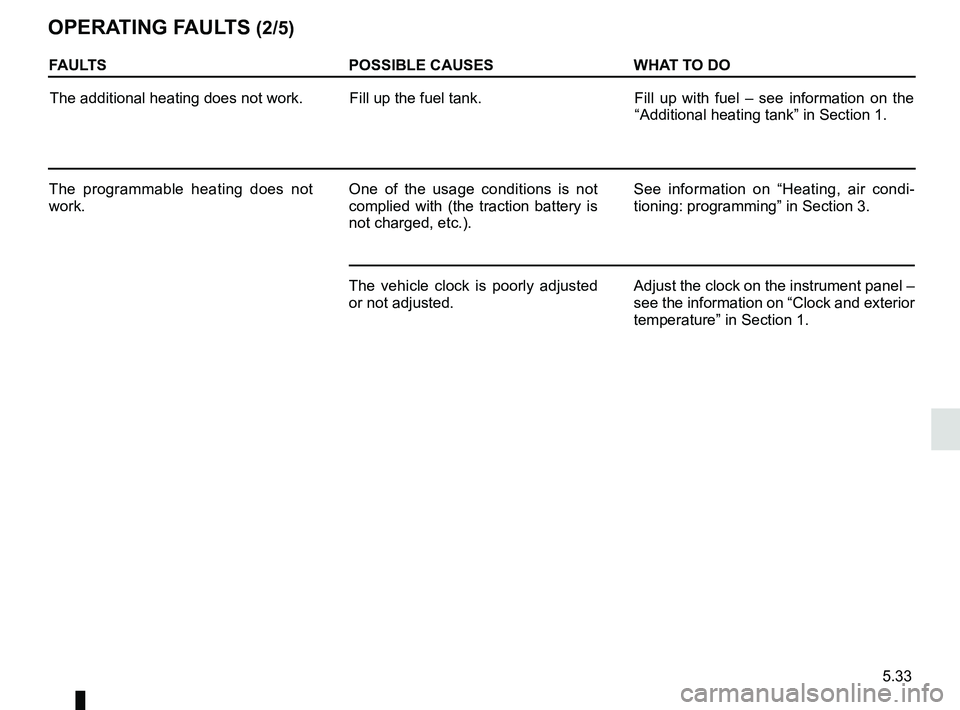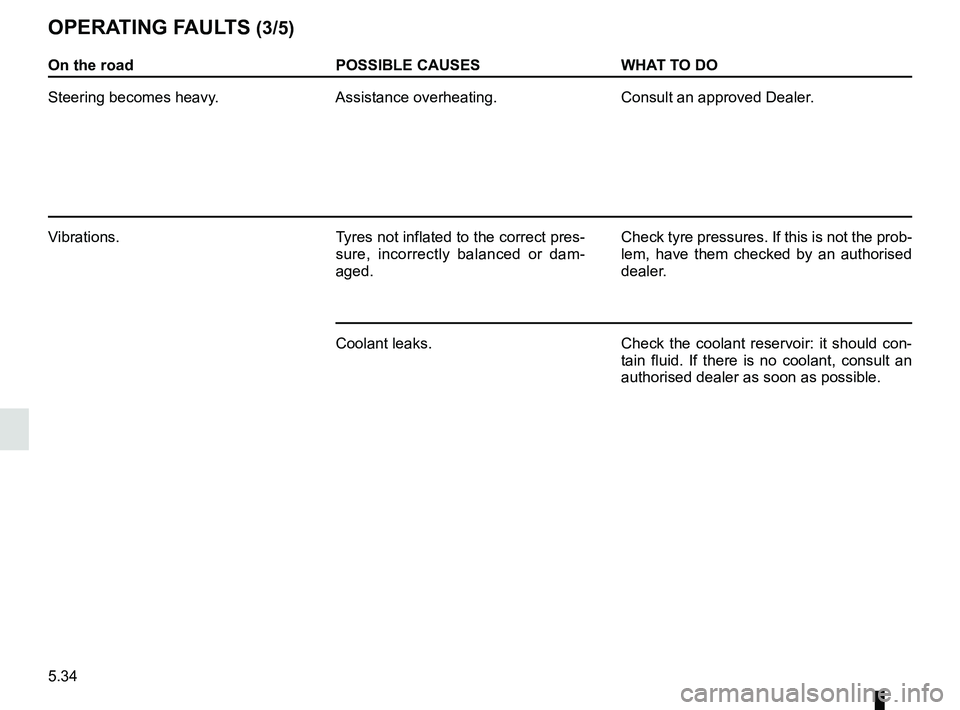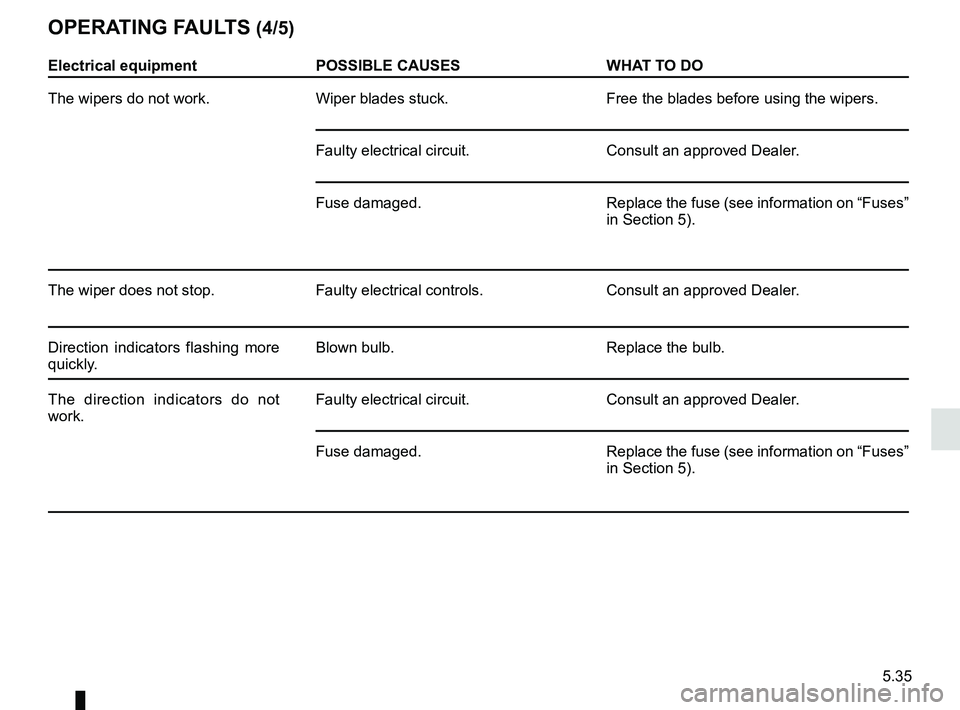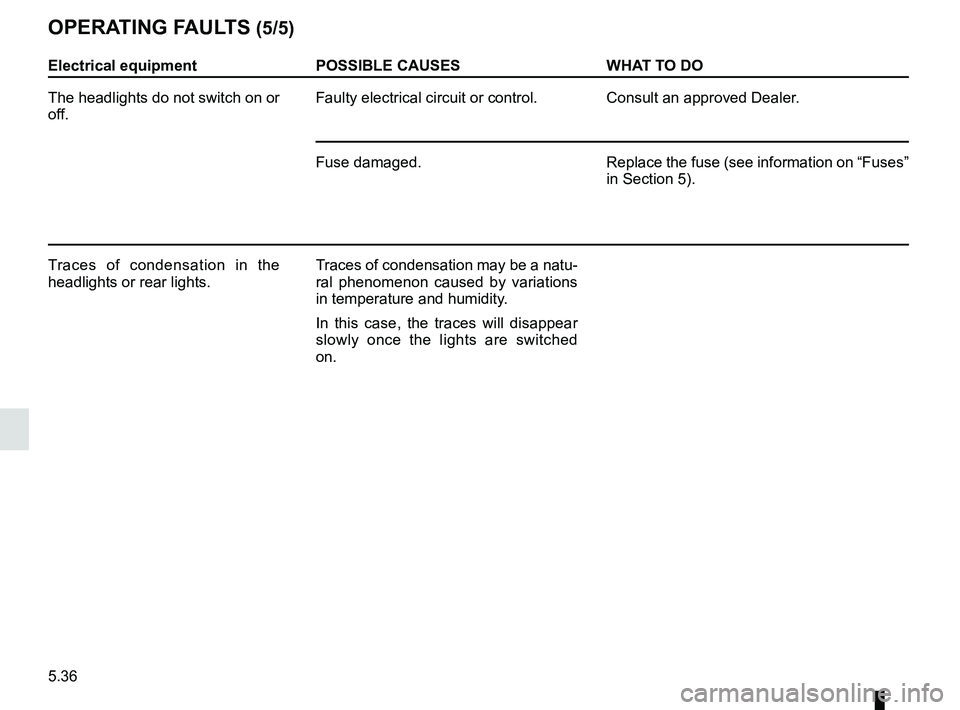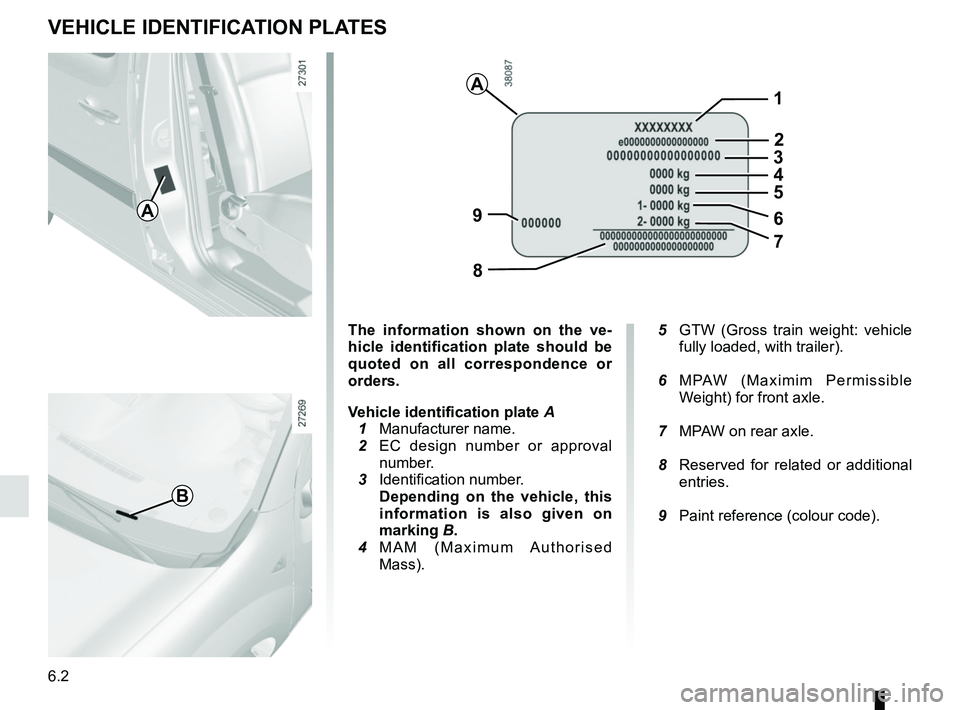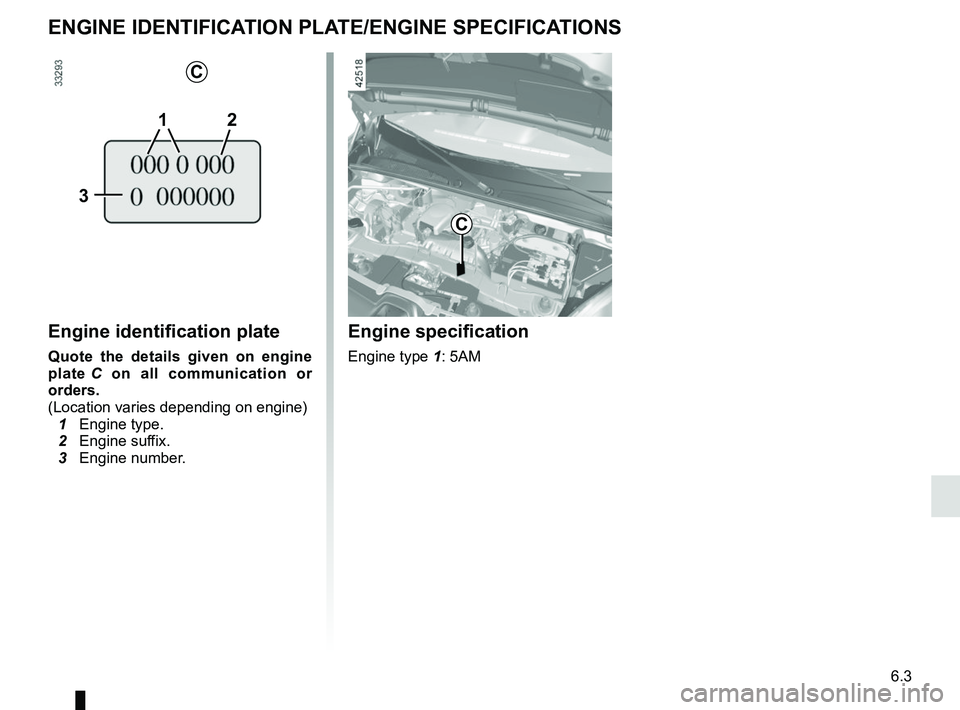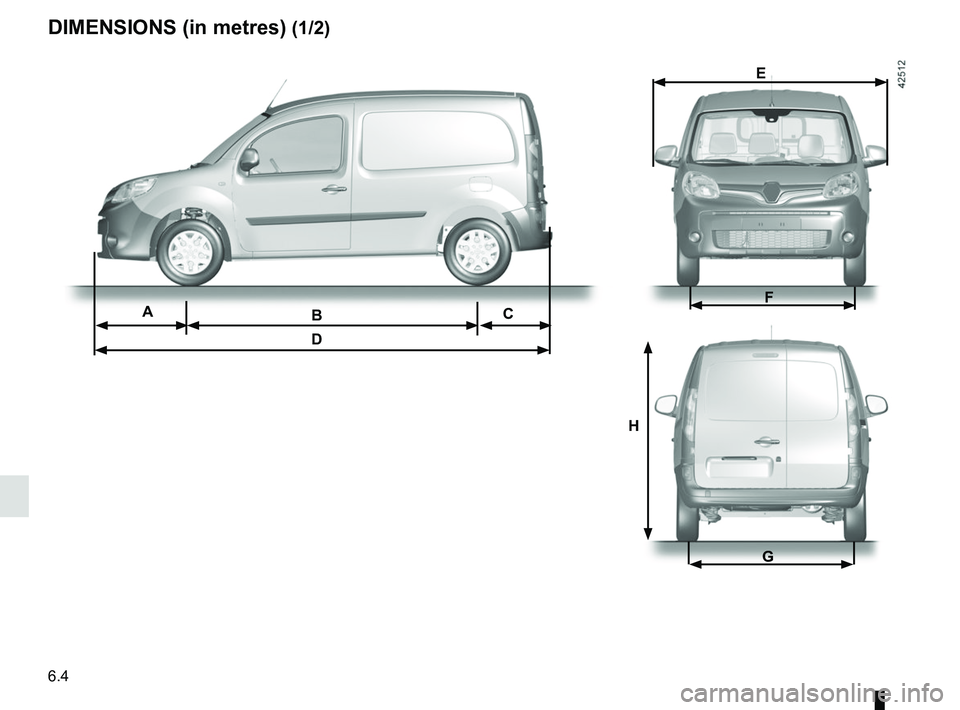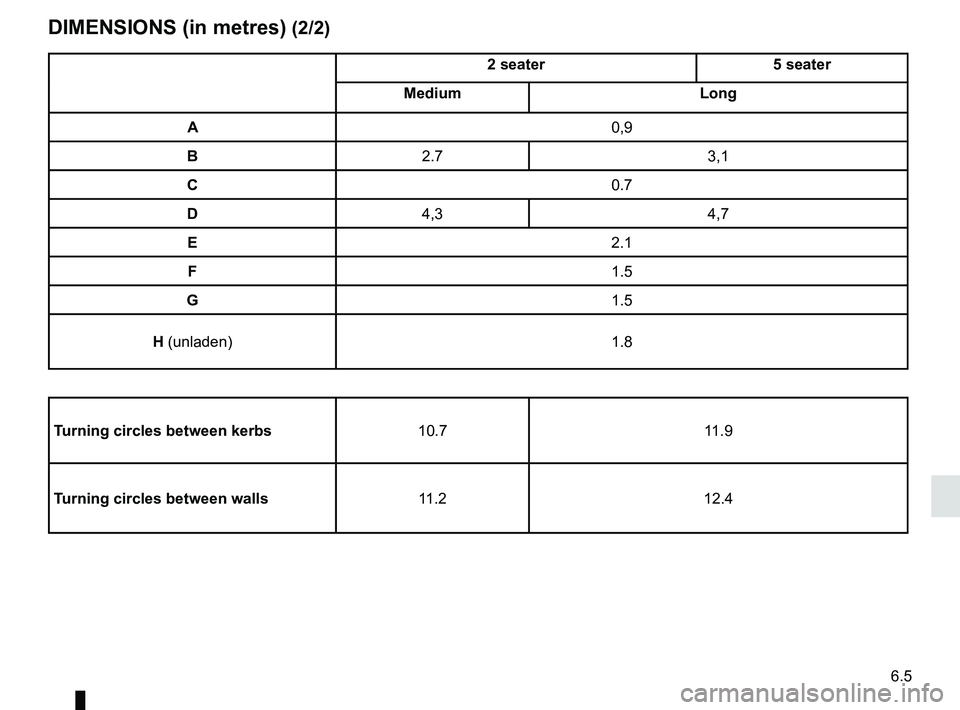RENAULT KANGOO Z.E. 2018 Owners Manual
KANGOO Z.E. 2018
RENAULT
RENAULT
https://www.carmanualsonline.info/img/7/58401/w960_58401-0.png
RENAULT KANGOO Z.E. 2018 Owners Manual
Trending: heating, parking sensors, handbrake, headrest, mileage, phone, service
Page 201 of 230
5.33
FAULTSPOSSIBLE CAUSESWHAT TO DO
The additional heating does not work. Fill up the fuel tank. Fill up with fuel – see information on the
“Additional heating tank” in Section 1.
The programmable heating does not
work. One of the usage conditions is not
complied with (the traction battery is
not charged, etc.).See information on “Heating, air condi-
tioning: programming” in Section 3.
The vehicle clock is poorly adjusted
or not adjusted. Adjust the clock on the instrument panel –
see the information on “Clock and exterior
temperature” in Section 1.
OPERATING FAULTS (2/5)
Page 202 of 230
5.34
On the roadPOSSIBLE CAUSESWHAT TO DO
Steering becomes heavy. Assistance overheating.Consult an approved Dealer.
Vibrations. Tyres not inflated to the correct pres-
sure, incorrectly balanced or dam-
aged. Check tyre pressures. If this is not the prob-
lem, have them checked by an authorised
dealer.
Coolant leaks. Check the coolant reservoir: it should con-
tain fluid. If there is no coolant, consult an
authorised dealer as soon as possible.
OPERATING FAULTS (3/5)
Page 203 of 230
5.35
Electrical equipmentPOSSIBLE CAUSES WHAT TO DO
The wipers do not work. Wiper blades stuck. Free the blades before using the wipers.
Faulty electrical circuit. Consult an approved Dealer.
Fuse damaged. Replace the fuse (see information on “Fuses”
in Section 5).
The wiper does not stop. Faulty electrical controls. Consult an approved Dealer.
Direction indicators flashing more
quickly. Blown bulb.
Replace the bulb.
The direction indicators do not
work. Faulty electrical circuit.
Consult an approved Dealer.
Fuse damaged. Replace the fuse (see information on “Fuses”
in Section 5).
OPERATING FAULTS (4/5)
Page 204 of 230
5.36
Electrical equipmentPOSSIBLE CAUSES WHAT TO DO
The headlights do not switch on or
off. Faulty electrical circuit or control. Consult an approved Dealer.
Fuse damaged.
Replace the fuse (see information on “Fuses”
in Section 5).
Traces of condensation in the
headlights or rear lights. Traces of condensation may be a natu-
ral phenomenon caused by variations
in temperature and humidity.
In this case, the traces will disappear
slowly once the lights are switched
on.
OPERATING FAULTS (5/5)
Page 205 of 230
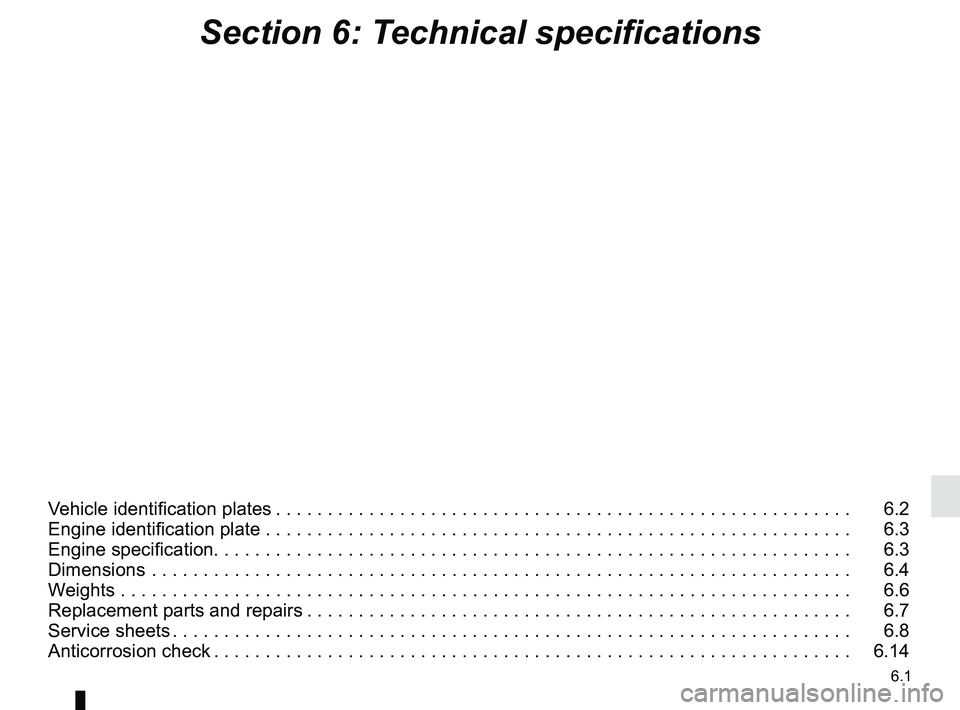
6.1
Section 6: Technical specifications
Vehicle identification plates . . . . . . . . . . . . . . . . . . . . . . . . . . . . . . . . . . . . \
. . . . . . . . . . . . . . . . . . . . 6.2
Engine identification plate . . . . . . . . . . . . . . . . . . . . . . . . . . . . . . . . . . . .\
. . . . . . . . . . . . . . . . . . . . . 6.3
Engine specification. . . . . . . . . . . . . . . . . . . . . . . . . . . . . . . . . . . . \
. . . . . . . . . . . . . . . . . . . . . . . . . . 6.3
Dimensions . . . . . . . . . . . . . . . . . . . . . . . . . . . . . . . . . . . .\
. . . . . . . . . . . . . . . . . . . . . . . . . . . . . . . . 6.4
Weights . . . . . . . . . . . . . . . . . . . . . . . . . . . . . . . . . . . .\
. . . . . . . . . . . . . . . . . . . . . . . . . . . . . . . . . . . 6.6
Replacement parts and repairs . . . . . . . . . . . . . . . . . . . . . . . . . . . . . . . . . . . . \
. . . . . . . . . . . . . . . . . 6.7
Service sheets . . . . . . . . . . . . . . . . . . . . . . . . . . . . . . . . . . . . \
. . . . . . . . . . . . . . . . . . . . . . . . . . . . . . 6.8
Anticorrosion check . . . . . . . . . . . . . . . . . . . . . . . . . . . . . . . . . . . . \
. . . . . . . . . . . . . . . . . . . . . . . . . . 6.14
Page 206 of 230
6.2
VEHICLE IDENTIFICATION PLATES
A
B
A
The information shown on the ve-
hicle identification plate should be
quoted on all correspondence or
orders.
Vehicle identification plate A
1 Manufacturer name.
2 EC design number or approval
number.
3 Identification number.
Depending on the vehicle, this
information is also given on
marking B.
4 MAM (Maximum Authorised
Mass).
5 GTW (Gross train weight: vehicle
fully loaded, with trailer).
6 MPAW (Maximim Permissible
Weight) for front axle.
7 MPAW on rear axle.
8 Reserved for related or additional
entries.
9 Paint reference (colour code).
7
8
96
5
4
3
2
1
Page 207 of 230
6.3
Engine identification plate
Quote the details given on engine
plate C on all communication or
orders.
(Location varies depending on engine)
1 Engine type.
2 Engine suffix.
3 Engine number.
ENGINE IDENTIFICATION PLATE/ENGINE SPECIFICATIONS
2
3
1
C
C
Engine specification
Engine type 1: 5AM
Page 208 of 230
6.4
DIMENSIONS (in metres) (1/2)
H
B
DACF
G
E
Page 209 of 230
6.5
DIMENSIONS (in metres) (2/2)
2 seater5 seater
Medium Long
A 0,9
B 2.7 3,1
C 0.7
D 4,3 4,7
E 2.1
F 1.5
G 1.5
H (unladen) 1.8
Turning circles between kerbs 10.711.9
Turning circles between walls 11.212.4
Page 210 of 230
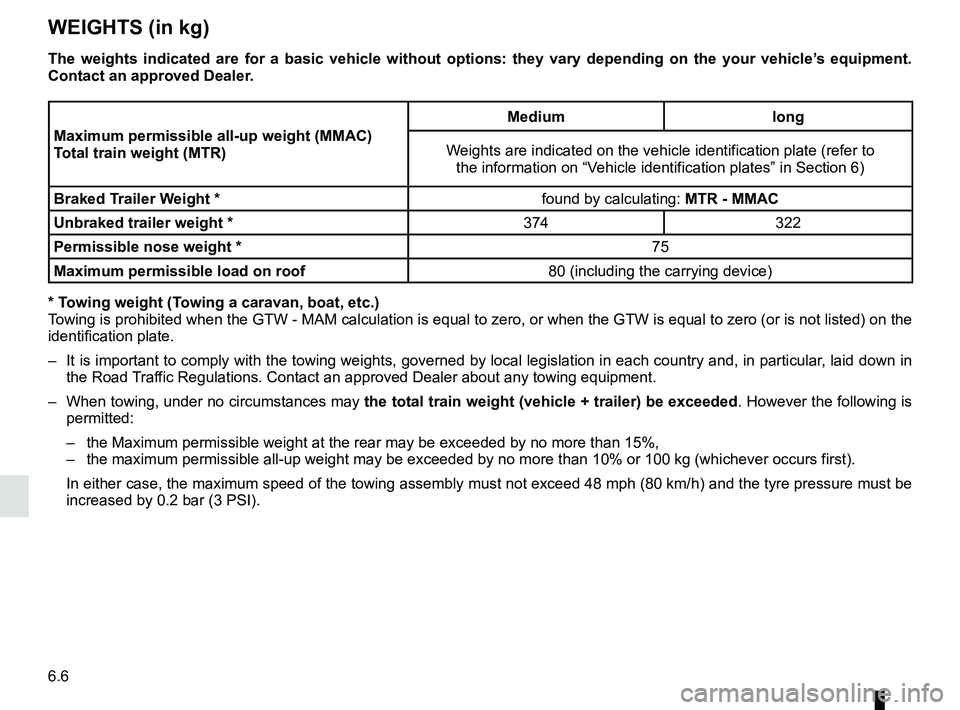
6.6
WEIGHTS (in kg)
The weights indicated are for a basic vehicle without options: they vary\
depending on the your vehicle’s equipment.
Contact an approved Dealer.
Maximum permissible all-up weight (MMAC)
Total train weight (MTR)Medium long
Weights are indicated on the vehicle identification plate (refer to the information on “Vehicle identification plates” in Section 6)
Braked Trailer Weight * found by calculating: MTR - MMAC
Unbraked trailer weight * 374 322
Permissible nose weight * 75
Maximum permissible load on roof 80 (including the carrying device)
* Towing weight (Towing a caravan, boat, etc.)
Towing is prohibited when the GTW - MAM calculation is equal to zero, or \
when the GTW is equal to zero (or is not listed) on th e
identification plate.
– It is important to comply with the towing weights, governed by local leg\
islation in each country and, in particular, laid down in the Road Traffic Regulations. Contact an approved Dealer about any towing equipment.
– When towing, under no circumstances may the total train weight (vehicle + trailer) be exceeded . However the following is
permitted:
– the Maximum permissible weight at the rear may be exceeded by no more th\
an 15%,
– the maximum permissible all-up weight may be exceeded by no more than 10\
% or 100 kg (whichever occurs first).
In either case, the maximum speed of the towing assembly must not exceed\
48 mph (80 km/h) and the tyre pressure must be increased by 0.2 bar (3 PSI).
Trending: battery replacement, tow, glove box, tailgate, oil, wiper blades, washer fluid
